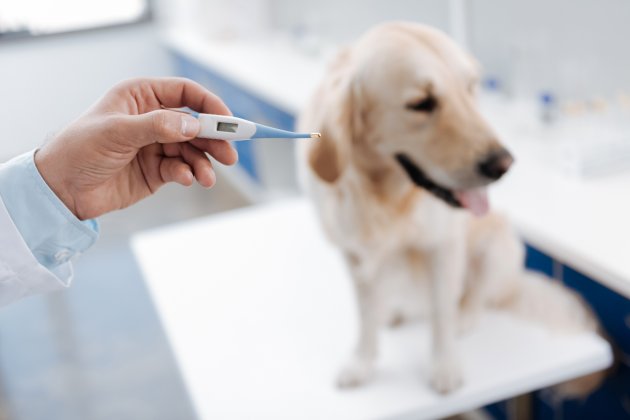Just like people, our pets can get feverish. And just like people, you will want to know exactly how high your pet's temperature is, so you will know when it's time to bring him or her to the veterinarian.
However, taking your pet's temperature can be a scary thought, especially when you've never done it before.
Don't fear.
In this post, we will explore the top 10 best pet thermometers (both rectal and infrared/ear) with the pros and cons of each model. Plus, we'll also give you some tips and a guide on how to use and choose the best pet thermometer for your furry friend.
Let's get started!
Our Top Picks for the Best Pet Thermometer
Don't know where to begin when it comes to choosing the best pet thermometer? No worries. We've tracked down 10 of the top pet (and people) thermometers on the market today. Check them out so you can make an educated purchase.
iProven Pet Thermometer (Termometro)

Comfortable. Fast. Flexible. These are the three perks that come with using the iProven Pet Thermometer. This unit works fast, getting a reading in 20 seconds, so your pet won’t have to endure the procedure any longer than necessary. Plus, it’s also waterproof, so cleaning the thermometer is a snap.
pros
- Flexible for easier insertion
- Easy to clean (waterproof)
- Affordable
- Accurate
- Fast - takes a reading in 20 seconds
- Easy to read
- Money-back 100-day guarantee
cons
- None to report
Enji Prime Thermometer

This digital thermometer is fast (only takes 10 seconds for reading) and is safe enough to use on people and pets. Used by animal clinics, human hospitals, schools, and sports clubs, the Enji Prime Thermometer is a trusted source for an accurate temperature. The soft flexible tip makes insertion a breeze, while the waterproof design and handy storage case keep this unit in tip-top shape.
pros
- Can be changed from Celsius to Fahrenheit
- Flexible tip
- Waterproof
- Come with batteries and a handy storage case
- Quick and accurate
- Complimentary ebook with purchase
- Trusted by both human and animal clinics
- Durable
- Economical
- Money-back guarantee
cons
- None to report
ANIKUV Forehead Digital Thermometer

Don’t want to mess around with a rectal thermometer? Then try the ANIKUV Forehead Digital Thermometer on your pet today. This handy unit has a special setting just for our furry companions in “Animal Mode,” so you can take Fido’s temperature quickly and easily - just point and press! It incorporates the most up-to-date medical technology, so you can rest assured that its readings are accurate.
pros
- Non-invasive as it uses infrared technology
- Quick and accurate
- Has both Celcius and Fahrenheit readings
- Economical
- Stores up to 99 readings in its memory bank
- Three screen colors change according to the level of fever (green/normal, orange/slight, red/high).
- Can be set to alarm when fever is high.
- Registers on the forehead or the ear.
- 1-year guarantee
- Only takes one second to get a reading
cons
- Because it uses infrared, there may be a slight margin of error.
Care Touch Digital Thermometer

With a flexible tip and a fast reading, the Care Touch Digital Thermometer will be a great addition to your pet's First Aid Kit. This unit takes your pet's temperature in 10 to 30 seconds and has a fever alarm so you will know instantly if your pet needs medical attention. The last reading recall makes tracking your pet's temp a breeze, as does the Celsius to Fahrenheit option.
pros
- Quickly takes a temperature reading
- Flexible tip for easier insertion
- Works on people, too
- Fever alarm
- Last reading recall button
- Waterproof
- Automatic shut-off conserves battery life.
cons
- There have been some complaints of it being inaccurate
- Probe covers need to be replaced
KAMSAY Digital Medical Thermometer

With no mercury to worry about, the Kamsay Digital Medical Thermometer is great for both pets and people. This FDA approved thermometer comes with many features for both accuracy, and convenience like the backlit screen for dimly lit areas, fast readings in 10 seconds, and a flexible tip for easy insertion. Plus, this unit is water-resistant and easy to clean.
pros
- Fast and accurate readings in 10 seconds
- Comes with a replacement battery
- Large LCD
- Soft, flexible tip
- Reads in both Celsius and Fahrenheit
- Can be used orally or in the rectum
- Fever alarm
- FDA certified
- 1-year warranty
cons
- Probe covers need to be replaced
- Only registers to 107.6
VEDIK Basal Digital Thermometer

Even though this thermometer is recommended for fertility tracking, you can also use it on your pets. It has a soft flexible tip for your pet's comfort and fast readings so you can get the task done quickly and accurately, The Vedik Basal Digital Thermometer is also waterproof and has been calibrated to 1/100th of a degree.
pros
- Safe and easy to use
- Calibrated for accuracy
- Soft, flexible tip
- Memory function with last reading recall
- Waterproof
- Automatic shut off
cons
- If stored in a cold room, it will take longer to get a reading
ACCUIT Digital Forehead and Ear Thermometer

Hold. Scan. Release. Read. That’s all it takes to get your pet’s temperature with the Accuit Digital Forehead/Ear Thermometer. The large numbers and LED screen are easy to read and turns from green (normal temp) to red for a fever. It’s fast taking your pet’s temperature in meer seconds with its infrared technology. Plus, it also comes with a convenient plastic cover so you can keep the unit safe and clean until the next usage.
pros
- Large LED display with temperature changing ID colors
- Protective cap
- Uses infrared technology
- Memory storage
- Comes with protective drawstring carrying case
- Easy three-step process
cons
- May not be 100% accurate when used on pets
Pet Clinic Thermometer for Dog, Cat, Rabbit

Great for all types of animals, the Pet Clinic Thermometer may be the one for you and your furry pals. Designed with pets in mind this digital, infrared thermometer takes your pet’s temperature in one second, so you won’t have to hold him still to get the task done - just point it at your pet’s ear.
Plus, this unit holds up to 30 readings, so you can better gauge your pet’s progress.
pros
- Made with pet’s in mind
- Good storage of past readings
- Can also be used to measure air temperature and milk in bottles
- A quick read in one-second
- Non-invasive
cons
- May be considered pricy
aurynns Pet Thermometer

Do you have a horse or other large animal? Then the aurynns Pet Thermometer may be the one for you. This unit can be used on large and small animals as well as birds. It has an automatic shut off and a longer probe to accommodate any pets. Plus, an alarm will sound if your furry critter is running a fever, so you won’t have to do any guess-work.
pros
- Made for pets
- Longer probe for easier insertion
- Fever-alert alarm
- Takes a temperature in 20 seconds
- Can be used orally or through the rectum
cons
- Cannot switch from Celsius to Fahrenheit by yourself
- Not waterproof
Fast Clinical Pet Ear Thermometer

Takes a reading in as quick as one second, the Fast Clinical Pet Ear Thermometer is a wonder to use. The large display allows for fast, easy reading, while the backlit screen illuminates the numbers. The preset alarm alerts you to a high reading, and it’s also switchable between Celsius and Fahrenheit.
pros
- Designed for pets
- Non-invasive
- Quick readings
- On/off switch and voice-activated
- Stores up to 32 readings
- Also, measure room temperature and liquids
- Uses infrared technology
cons
- Some reports of inconsistency
Guide to Using the Best Pet Thermometer
Now that we've found out what the best pet thermometers are, let's dive into some important information when it comes to using one.
How to Use a Rectal Thermometer
Although not a difficult task to accomplish, taking your pet's temperature rectally is best performed with two people (optimal is with someone your pet knows and likes). Have your pet either in a standing position or lying on its side. Talk to him in a calm and soothing voice.

If you are using a digital thermometer follow the instructions of the model. If you are using a traditional mercury thermometer, you will have to shake it to let the mercury settle. You will also want to lubricate the unit with petroleum jelly.
Now, lift your pet's tail and insert the unit as per its instructions, or with the mercury kind, insert it by gently twisting and pushing it from one to three inches depending on your dog's size.
Every thermometer is different, so again, read those instructions on the model you choose, or with the traditional mercury thermometers, you will have to wait about two minutes to get an accurate reading.
Once your thermometer has taken a reading, wipe it clean.
How to Use an Infrared or Ear Thermometer
Ear or infrared thermometers are a less invasive way to take your pet's temperature and work by measuring the heat waves coming from your dog's eardrum. However, if not used properly, they can also be less accurate. Again, read those instructions and follow them to get the most reliable reading.

Normal Temperatures for Pets
You won't know if your pet has a fever if you don't know what a normal temperature is. Here are the normal temperatures for some common pets.
- Dogs - 101 to 102.5 F
- Cats - 99.5 to 102.5 F
- Rabbits - 100.5 to 103.5 F
- Horse - 99 to 101 F
When Should I Contact a Vet?
If your pet's temperature rises above the normal range and stays there it could be a sign of an infection or an illness, so you should seek veterinary attention immediately. Even a low temperature is dangerous and could be a sign of shock or illness.
It's always best to err on the side of caution when it comes to an abnormal temperature in your pet. Using a pet thermometer is your first step to determining when your pet needs medical help.